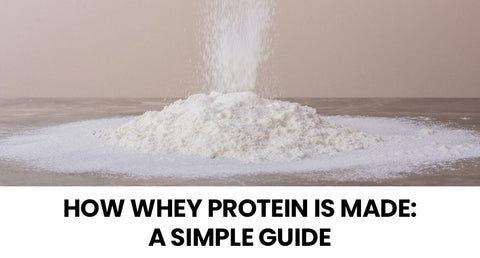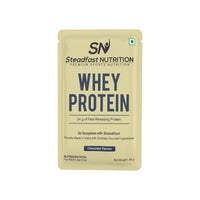Table of Content
Whey protein, a by-product of cheese production, is a complete protein containing all nine essential amino acids. It is prized for its high digestibility, rapid absorption, and adequate nutritional profile, making it a cornerstone in fitness and health nutrition. It is particularly sought after by athletes and fitness enthusiasts for its rich branched-chain amino acid content, especially leucine which stimulates muscle protein synthesis. In this blog, we will get in-depth knowledge of how whey protein is made from scratch.
Why It’s Popular
- Muscle Growth and Recovery: A favourite among athletes and gym-goers, whey protein enhances muscle repair and promotes recovery after workouts.
- Weight Management: Its high protein content helps reduce appetite, support fat loss, and preserve lean muscle mass.
- Convenience and Versatility: Available in powder form, it’s easy to incorporate into shakes, smoothies, or recipes.
- Scientific Validation: Research supports its effectiveness in improving athletic performance and ease of digestion & absorption.
Why Knowing the Process Matters
Whey is extracted from milk during cheese production, separated from casein, and processed into forms like concentrate, isolate, and hydrolysate. Each type provides unique benefits, such as higher protein content or faster absorption. Understanding these distinctions helps you choose the right type of whey protein to meet your requirements and desired goals.
Its benefits and versatility have glued people towards whey protein making it a trusted supplement, especially with fitness enthusiasts and health-conscious individuals.
What Is Whey Protein?
Whey protein is the dried form of whey water separated from milk during the processing of different milk products. Whey protein is a high-quality, complete protein that contains all nine essential amino acids that your body needs but cannot produce on its own. It is known for its excellent digestibility and fast absorption, making it a popular choice for muscle building, recovery, and overall health improvement.
Where Does Whey Protein Come From?
Whey protein completely originates from milk, which is composed of 80% casein and 20% whey. During the production of cheese, milk is acidified and curdled which causes the casein to form solid clumps (curd) while the whey protein remains in the liquid form. Then this liquid whey is processed to remove water, carbohydrates, fats, lactose, and minerals resulting in a concentrated protein in the form of powder.
The refined whey can be further processed into various forms such as:
- Whey Concentrate: It provides 80% protein with some carbohydrates and fats.
- Whey Isolate: it has 90% protein content with minimal carbohydrates and fats.
- Whey hydrolysate: It has more than 90% protein content and a predigested protein form for faster absorption.
Historically considered a by-product, whey has evolved into a dietary supplement due to its rich amino acid profile and versatile applications. It’s an excellent addition to a healthy diet, supporting fitness goals, weight management, and daily protein requirements.
Step-by-Step Guide to How Whey Protein Is Made
Here are the steps to make whey protein from scratch:
1. Milk Collection
Fresh milk is sourced from grass-fed cows, ensuring high quality. Milk contains 20% whey and 80% casein.

2. Transport and Pasteurisation
Milk is transported in refrigerated tanks to processing facilities, where it is pasteurised to kill harmful bacteria without affecting its nutrients.
3. Milk Separation
Enzymes are added to separate milk into curds (used for cheese) and liquid whey, the base for whey protein production.
4. Micro-Filtration
Liquid whey is filtered to remove fats, carbohydrates, and water, resulting in whey protein concentrate.

5. Ultra-Filtration (For Isolate)
For whey protein isolate, the concentrate undergoes further filtration to remove virtually all lactose and fat.
6. Spray Drying
The concentrated whey is dried using hot air to produce a fine powder while preserving its nutritional value.

7. Blending and Flavouring
The unflavoured powder is blended with natural flavours, sweeteners, and emulsifiers for better solubility and taste.
8. Packaging and Quality Control
The final product is sealed in eco-friendly containers and rigorously tested for protein content, purity, and safety before being distributed.
This meticulous process ensures whey protein is a high-quality, nutrient-rich supplement suitable for fitness enthusiasts and health-conscious individuals.
Types of Whey Protein
Whey protein is available in three primary forms: whey protein concentrate (WPC), whey protein isolate (WPI), and whey protein hydrolysate (WPH). Whey Protein Concentrate (WPC) contains 70–80% protein and retains small amounts of fat, lactose, and immune-enhancing peptides. It is the most cost-effective option, making it a popular choice for beginners and those aiming to build muscle.
Whey Protein Isolate (WPI) is further processed to achieve a higher protein concentration of around 90 to 95%, with minimal fat and lactose content (approximately 5%). This makes it ideal for people focused on lean muscle development as it easily utilised by the muscles without
Whey Protein Hydrolysate (WPH) is the most advanced form, offering around 99% protein content. It undergoes hydrolysis, a process that pre-digests the protein for enhanced absorption and digestibility. This highly water-soluble form is widely used in medical protein supplements due to its pre-digested and partially hydrolysed form along with reduced allergen potential making it easy for digestion & absorption. WPH is particularly beneficial for rapid recovery, muscle synthesis and immune support, making it the top choice among whey protein options.
Conclusion
Whey protein’s journey from milk to the final powdered product is a testament to the precision and innovation involved in modern nutrition. Each step, from milk collection to quality testing and packaging, ensures a product that is safe, effective, and nutritionally rich. Whether you’re an athlete, a fitness enthusiast, or someone simply looking to enhance your protein intake, understanding how whey protein is made can help you appreciate its value and benefits. By choosing the right type of whey protein, you can align your nutrition with your health and fitness goals, paving the way for a stronger, healthier you.
Steadfast Nutrition offers best whey protein range made from the finest and high- quality whey protein. The brand ensures top quality by using advanced filtration methods and conducting regular testing throughout production. This guarantees purity, high protein content, and consistency in every batch. Steadfast Nutrition's whey protein supports fast absorption, rapid recovery, and lean muscle growth, making it a trusted choice for athletes and fitness enthusiasts.
FAQs
1. What is whey protein made from?
Whey protein is made from cow’s milk. It is the liquid portion of milk that is separated during the cheese-making process. Whey protein contains all nine essential amino acids, making it a complete protein. It is rich in branched-chain amino acids (BCAAs) and has a high biological value, meaning it is easily absorbed by the body.
2. How is whey protein separated from milk?
During the process of cheese production, the milk is acidified and curdled causing the casein to form solid clumps while the whey protein remains in the liquid form. Then, the whey liquid separated is processed and filtered to eliminate most of the lactose and fat. Hence, resulting in concentrated whey protein powder. The final product is dried into a fine whey powder.
3. Why is whey protein popular?
Whey protein is popular because it supports muscle growth, recovery, and overall health. It is fast-digesting, making it ideal for post-workout recovery. Additionally, it helps with weight management by promoting satiety and preserving lean muscle mass. Its high protein content, versatility, and convenience have made it a go-to supplement for athletes, fitness enthusiasts, and those looking to increase protein intake.
4. Is whey protein suitable for everyone?
Whey protein is suitable for most people, but it may not be ideal for individuals with lactose intolerance or a dairy allergy. People with these conditions may experience digestive discomfort or allergic reactions. For those who are lactose intolerant, whey protein isolate (which has minimal lactose) may be a better option. Additionally, vegans or individuals avoiding animal-based products can choose plant-based protein alternatives. Always consult a healthcare provider before starting a supplement, especially if you have specific health concerns.


